Below is the project promotional video for Hands of a DJ, Pixel Juice Pimped and Popped:
Presentation
Below is my presentation slides that I plan to use next week on the 14th. I will also take the book in, along with a copy of Pixel Juice as visual aids:
Reflection
Throughout this project, I have had to acquire a number of new skills. I have found that I learn best through practically playing with materials and by doing rather than spending time reading around. I have also found video tutorials a much easier medium to digest practical skills over reading books. I have used lots of experimentation
I understand that I have anxiety to deal with when under pressure and I handle this through throwing money towards the project to try and preempt what I could possibly need, rather than stepping back and working out what I actually need. It gives me the false sense of control. This was a very over ambitious project with lots of new learning involved. It was through the prototyping stage that I realised that I had underestimated the amount of time I would need to complete one book, let alone the three that I had planned. It has been a struggle to get the book delivered within the time frame. I should have realised earlier that I would not be able to deliver on all three, but my professional pride and stubbornness prevented me in admitting that it was too much.
Unlike during my undergrad project, I started a new and challenging job role along with being a mother of a young child with older parents. This has at times been challenging personally and I have had to juggle and sacrifice far more throughout this year than anticipated. There were times though this project where I thought I would have to walk away and give up. Having deferred last year, the thought of having to put SAC’s in again and try again next year was not an option I was willing to take. It was incredibly hard for me to see the end point and to also accept that at times, I have had to say that “this will do” and not strive for absolute perfection.
Some of the creative decisions have come from when it hasn’t quite gone right or through experimentation. I tend to play whilst designing and find that I often go off piste. I’m also a list maker, whether that be on my phone, using the notes feature or post it notes that I can manually cross out.
I keep experimenting as part of the design process, until I am happy that I have found the best solution possible, I enjoy watching something evolve as it is worked on, rather than trying to plan too much. I find planning design quite restrictive. I’m also fastidious with the aesthetics and tend to overwork and not know when to stop. Looking back, I spent such a long time working on the images for the stories. I was also trying to work on all three in the beginning and this was a mistake. I should have concentrated on completing one story, rather than doing the same task for all three stories, as this did not help me work out whether my time planned was realistic or not. If I had concentrated on book one first, then I would have worked out much earlier that my original planning was unrealistic and this would have save me from wasting time on trying to complete all three. I’ve learnt that I’m still overambitious and can get overwhelmed when I feel out of control. There were a few points where I just stopped working for a couple of weeks and hid, rather than tackling the project head on. When I did start tackling, my motivation was high as I progressed. There were times when technically, I couldn’t work out why elements were not working. I realise that it is good to sleep on it and often by the next day, I would have worked out the issue or at least thought of some options to try. Having supervision every three weeks has also helped me keep on track. I would go, even when I hadn’t progressed much, but the fact that the meetings were booked in, meant that I had to do something and kept the project ticking along.
As my daughter is 4 now, it has been harder to explain why I was going to uni at the weekends and working late. Dealing with the guilt has been very hard this year. It was easier when she was younger. I have ensured that Saturdays would be our day together and I would give Sundays to the Masters. Now I’m very close to the end, I can look back and see how far I have come. It has been an amazing learning experience and this project has taught me resilience and perseverance to the end to get it completed. A few weeks ago, I was deeply unhappy with the end result, but on reflection and taking everything into consideration, I’m proud of what I have managed to achieve. My plans moving forward is to keep the project going and to move on to the next story.
Evaluation against “The Pleasure Framework”
I have often referred to Costello’s (2007) “Pleasure Framework” when designing, creating and evaluating interactive installations. At the beginning of this projecting, during the planning stages, I had already identified the framework to work with for the design stage. Now I am approaching the end of this piece, it seem appropriate to use the same framework to evaluate its effectiveness.
Costello has identified thirteen areas of pleasure that an interactive artwork may induce in a participant. However, she points out that it would be rare for all the pleasures to occur together in one art piece and that some may purposefully induce displeasure. From her own analysis using the framework against existing interactive artworks, most pieces exhibited two or three pleasures strongly, rather than all. Costello recommends using the framework during the design and prototype stage, for which I did both. It became particularly important during the prototype stage, where I had to strip back the functionality and decide what was desirable and what was necessary to ensure that this piece still worked as an engaging interactive art piece and true to the story. The link between play and exploration is highlighted in her article and she highlights how player boredom can make the player switch back into exploration mode, encouraging them to look for something new to engage and play with and therefore, experience a deepening engagement with the work.
With “Hands of a DJ”, most triggers are not explicit. There is little affordance given to the user. It forces the user to explore and once they have triggered one aspect, the epiphany moment will hopefully occur. It could easily happen accidentally, however, once the user realises that touch is the trigger, they will start to explore the piece to work out where the sounds are and hopefully create a narrative along the way. With a copy of the book, next to the piece, the user can either choose to read the narrative before, after or not at all. As humans, we naturally create our own narrative from prompts given. It is how we make sense of the world around us, so if the original text is not looked at, the user would have created their own from what I have given to them. It has crossed my mind to not include the original work, Pixel Juice, but I believe that it is so important, not only to acknowledge the inspiration to the piece but to add closure for the user to be able to find the story and to connect the dots if needed.
From the thirteen pleasures that Costello outlines, I have identified six that than be applied to the piece:
- The first is “Creation” – This is a small pleasure and is one of the pleasures that is the weakest shown in this piece, however, there is pleasure from being able to touch triggered sounds in your own rhythm and order to create your own narrative sound track.
- The second is “Exploration”. This is one of the strongest pleasures displayed in this piece. As mentioned, I haven’t really given the user any affordance in how to use and where to touch. I expect through accidental touch, that the user is then surprised and intrigued to work out the cause and effect and to explore how, why and where else sounds and lights may come from.
- The third is “Discovery”. This is related to “Exploration”. At a basic level, from the opening of the book, the discovery that it is a pop up and from exploring each flap, a discovery is made through the paper engineering, triggered sounds and lights. The realisation that touching cardboard is triggering interaction, means that the rule book is out of the window and that anything goes.
- The fourth is “Difficulty”. I would argue that this can be displayed in two ways. One example is the robohand lights. The user is only given the words “press, hold, stroke”. The action to get the lights working as intended is not easy and needs to be mastered. The other element of difficulty is on an intellectual level with the narrative. If the user chooses not to read the original story, then they have to piece the narrative together, and this could be challenging and hopefully, stimulating.
- The fifth is “Captivating”. This is not a strong pleasure in this piece, however, I feel it is there. The magic of sounds being trigger by touching a material that is not conductive will hopefully induce a sense of wonderment.
- The last pleasure is ” Sensation”. This piece is all about touch, movement and sound. This is one of the strongest pleasures in this piece and one that has been the basis of the design and technology chosen. The original story “Hands of a DJ” was very sound heavy and lent itself to be an aural piece.
During this evaluation, I am aware that as the creator, I am probably too close to the work to properly evaluate it. I know that I am approaching this from a creators perspective and it is hard to be objective when this has been an all consuming process over the last year. However, overall, I feel that it meets many pleasures through the play, sensation and exploration elements of the work and I hope that users will also feel the same too.
Costello, Brigid. (2007). A Pleasure Framework. Leonardo. 40. 370-371. 10.1162/leon.2007.40.4.370.
Creating the Video
It took around 2.5 hours to set up and record the footage for the film. I enlisted the help from a video expert, Andrew Burgess to assist me in filming and setting up the lighting for the shots. For my piece to camera, I have use the green screen to provide flexibility on the background. When filming the book, I chose a white background. We used an attached mic, SLR, auto-cue and 4 lights.
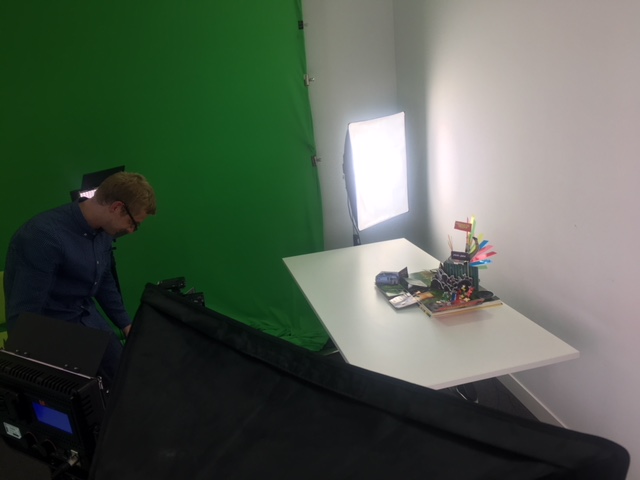
I have created the title clips and recorded separate voice narration for the story.
I’ve also added some keywords to pop up via PNG’s in Photoshop as I’m talking to the camera to add emphasis, using the technique observed when watching other promotional videos.
I’ve used two fonts, one that has been used in the project and the other so that it is easier to read.
I’ve recorded my voice into Camtasia for the story element, ready to add in and found a background hip hop loop that I’ve mixed with a scratch to create a suitable background sound to my video.
LS (2005) hip hop.wav https://freesound.org/people/LS/sounds/12045/ [Accessed 03/08/2018]
Jungle (2007) Scratch01.WAV https://freesound.org/people/junggle/sounds/29940/ [Accessed 26/03/2018]
I’ve used Premiere to do the editing in:
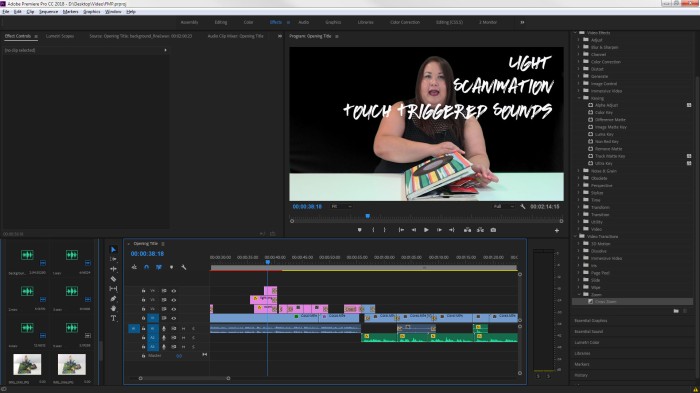
A late addition
I’ve decided to add on an additional pop up. When you listed the flap for the trailer, there was a lot of empty space. I decided to add pixel in, with a defensive position to represent the fight that her and Marco have. I have also added some extra acetate on the left side for lights by the stage.
Sources for Hands of a DJ
Below are all the sources that I have used to produce Hands of a DJ. Thank you to everyone who has put a creative commons licence on their image/sound:
Images:
picjumbo.com from Pexels (2015) Crowd in Front of People Playing Musical Instrument during Nighttime https://www.pexels.com/photo/crowd-in-front-of-people-playing-musical-instrument-during-nighttime-196652/ [Accessed 25/01/2018]
Digital Buggu (2015) Green Grass https://www.pexels.com/photo/green-grass-166651/ [Accessed 25/01/2018]
FWStudio (2016) Blue Lined Flat Surface https://www.pexels.com/photo/blue-lined-flat-surface-132204/ [Accessed 25/01/2018]
lalesh aldarwish (2016) Silhouette Photo of a Man in a Tunnel https://www.pexels.com/photo/silhouette-photo-of-a-man-in-a-tunnel-169978/ [Accessed 25/01/2018]
Pixabay (unknown) Gun https://www.pexels.com/photo/weapon-gun-ammunition-pistol-39030/ [Accessed 25/01/2018]
Pixabay (unknown) Blue and Black Butterfly https://www.pexels.com/photo/blue-and-black-butterfly-66268/ [Accessed 25/01/2018]
Pixabay (unknown) Green butterfly https://www.pexels.com/photo/butterfly-insect-wings-leaf-37404/ [Accessed 25/01/2018]
Pixabay (unknown) Yellow and Black Butterfly on Purple Flower at Daytime https://www.pexels.com/photo/butterfly-butterflies-composites-knapweed-56616/ [Accessed 25/01/2018]
Joe deSousa (2015) Silver Metal Round Gears Connected to Each Other https://www.pexels.com/photo/silver-metal-round-gears-connected-to-each-other-149387/ [Accessed 25/01/2018]
Pixabay (2017) Rainbow https://www.pexels.com/photo/abstract-art-artistic-background-459799/ [Accessed 25/01/2018]
Digital Buggu (2015) Grass https://www.pexels.com/photo/green-grass-166651/ [Accessed 01/05/2018]
Clker-Free-Vector-Images (2014) sunglasses-black-shades-dark https://pixabay.com/en/sunglasses-black-shades-dark-312051/ [Accessed 08/05/2018]
Max Pixel (Unknown) Fabric Pattern Photo Texture Red Background https://www.maxpixel.net/Fabric-Pattern-Photo-Texture-Red-Background-1168279 [Accessed 08/05/2018]
MarkScottAustinTX (2010) DJ Skittlez and DJ Toddy B at Submerged https://www.flickr.com/photos/elchupacabra/4789795583 [Accessed 08/05/2018]
Texturepalace (2016) rusty metal texture https://www.flickr.com/photos/122127718@N08/26284740723/ [Accessed 11/05/2018]
Engin_Akyurt (2016) glove https://pixabay.com/en/glove-el-fashion-shoot-white-fund-2644541/ [Accessed 14/05/2018]
Pixabay (unknown) Grayscale Photography of Mechanical Wheels https://www.pexels.com/photo/grayscale-photography-of-mechanical-wheels-159404/ [Accessed 21/05/2018]
Mishimoto (2009) Sziget chillout tent https://www.flickr.com/photos/mishimoto/4099268048 [Accessed 02/07/2018]
Mysteriouskyn (2006) A Man’s neck https://commons.wikimedia.org/wiki/File:Male_neck.jpg [Accessed 14/05/2018]
Richard Greenhill and Hugo Elias (2007), Shadow Hand Bulb large (Online) Alpha.png https://commons.wikimedia.org/wiki/File:Shadow_Hand_Bulb_large_Alpha.png [Accessed 11/05/2018]
Sound:
Nnus (2011) nnus_industrial_equipment_noise1.wav, https://freesound.org/people/nnus/sounds/126551/ [Accessed 26/03/2018]
Xenonn (2011) Layered Gunshots » Layered Gunshot 7.wav https://freesound.org/people/Xenonn/sounds/128297/ [Accessed 26/03/2018]
The.dude (2011) Scratch loop2.WAV https://freesound.org/people/the.dude/sounds/124395/ [Accessed 26/03/2018]
Jungle (2007) Scratch01.WAV https://freesound.org/people/junggle/sounds/29940/ [Accessed 26/03/2018]
Timbre (2010) remix of 74874 funk guitar https://freesound.org/people/Timbre/sounds/109970/ [Accessed 26/03/2018]
Bronxio (2014) Classic breakbeats – Apache (processed, 4 bar) https://freesound.org/people/bronxio/sounds/242963/ [Accessed 26/03/2018]
Timbre (2011) remix #1 of 23564__djduppy__duppyHipFunk03_120bpm.mp3 https://freesound.org/people/Timbre/sounds/121969/ [Accessed 26/03/2018]
Adam_N (2016) Crowd at concert.wav https://freesound.org/people/Adam_N/sounds/346683/ [Accessed 26/03/2018]
Tessa_Elieff (2013) Festival Inner.wav https://freesound.org/people/Tessa_Elieff/sounds/189518/ [Accessed 26/03/2018]
FunWithSound (2017) Butterfly Wings Fluttering.wav https://freesound.org/people/FunWithSound/sounds/402781/ [Accessed 28/03/2018]
InspectorJ (2016) Wind Chimes, A.wav https://freesound.org/people/InspectorJ/sounds/353194/ [Accessed 03/04/2018]
Video Script Plan
I have booked out the Development Suite at work to be able to use of green screen background and filming equipment, such as autocue, lighting, cameras. This will enable me to choose an appropriate background post production. I have also enlisted the help of my friend Andrew Burgess, who specialises in video and film. He is going to advise and help me film the video and I will work on the post production editing. Below is my plan on how I am going to shoot my video:
It will initially start with me introducing myself and outlining the project:
Title page “Pixel Juice, Pimped and Popped, Hands of a DJ”
Me talking to camera, with the book closed in front of me, my name in text shown:
“Hello, my name is Lucy Bamwo. I’m an interactive artist with a day job working in educational technology.
I’m going to introduce you to my latest interactive art project, “Hands of a DJ“. This is the start of a larger and ongoing project called “Pixel Juice Pimped and Popped“. A collection of Pop up books for adults.
Show the book Pixel Juice
Taking inspiration from “Pixel Juice”, a collection of short stories by the author, Jeff noon, I have interpreted and recreated “Hands of a DJ” into a single interactive pop up page book that engages the reader through light, scanimation and touch triggered sounds.
Open the book up
There are embedded technologies such as paper circuits, a Bare Conductive touch board mixed with electric paint and conductive fabric tape. The interactivity with the illusion of magic encourages the reader to play and explore in a novel and nostalgic way. ”
Camera shots of the book:
Zoom in on Pixel Juice, pan out to the crowd, click on button for Stage lights on the crowd:
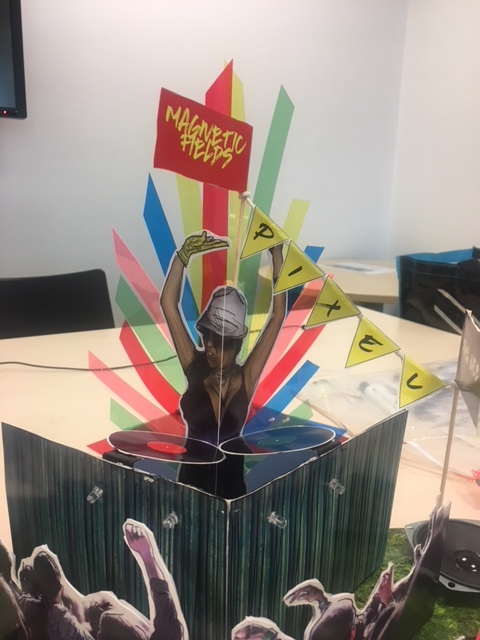
“Pixel Juice is the most renown and talented DJ headlining the magnetic field festival.”
Zoom on fingers touching the Decks – triggering sounds
“Her scratching is so deep, so fast, it’s inhuman.”
Close up on moving scanimation
“Cruising the giant relay screens, the gloved up hands of a woman, a constant blur, magnified thousand”
Shot of the sunglasses being removed out of pocket, being put on (blue lens on camera), move to pull up of Marco, trigger sound.
“the crowd is tripping to the voodoo groves. Lying in waiting on the outskirts, is the kid. He found a space in the crowd to call his own, He ain’t dancing, Hes got some other kind of thing going on”
Blue lens showing hidden message
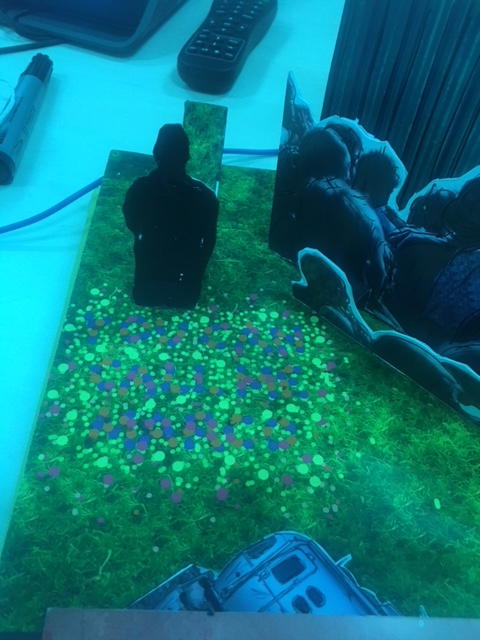
“They call him Marco.”
Opening of the trailer flap, show after party, then trailer
“The after gig party was a burnout zone. After playing her set, pixel Juice goes back to her bus, it’s dark with only the glitter of a record spinning. Marco lures Pixel to be alone with him, a vintage beat. He doesn’t want money, he has wants to be like her:
Open robohand and show lights, then move back to the Gun – shot noise
“His curiosity overwhelms him. The secret is unveiled, the hands of the DJ are revealed through the most deadly way.”
Close up on openin butterfly hand
Pan out to see whole book opened up

Back to me:
“This book is the first one of a planned series. If you are interested in the making of this project or any of my other projects,
End Title page with link on there
then please take a look at my blog: Lucybamwo.wordpress.com”
Robo hand lights fault and solutions
Ideally, when you use surface mount LEDs, you should solder the LEDs on to copper tape. As tried and tested previously, copper tape does not like to be bent and becomes brittle very quickly. Therefore, I have chosen to use conductive fabric tape throughout the book as there are folds at every point and the fabric tape works really well when bent. I therefore, used scotch tape to place the LEDs on top of the tape to hold them in place. This has caused a different problem of the LEDs not being securely pressed against the tape. It created inconsistent experience, sometimes all the LEDs came on, other times, some or none came on. My first instinct was to take it apart and start again with a more robust solution to securing the LEDs . However, after trying to push the LEDs down with my finger, I found that it was a more pleasurable experience to see the lights come on with the movement of my finger:
I didn’t want to add full instructions, but the reader needs some affordance to try and understand what to do. This is why I have chosen to add “Press, Hold, Stroke” to encourage them to do this action.
Front cover fail and why
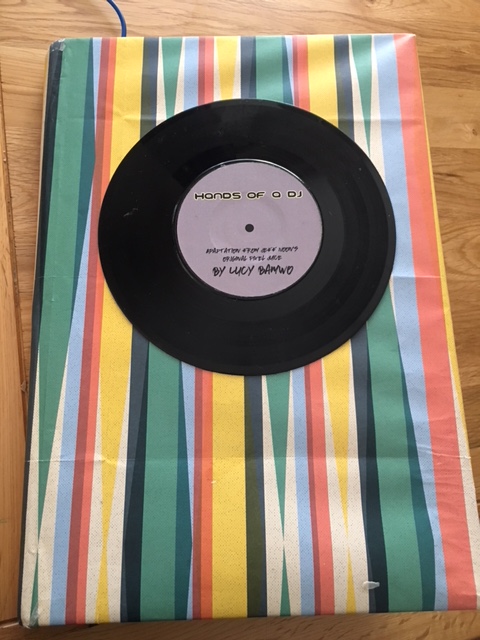
My intention has always been to have the front cover to be interactive, so that when you touched the vinyl, it triggers a sound. All the testing I had done previously, shown I could get this to work, especially when plugged into mains power. However, I did not factor in once everything is assembled how the competing capacitive touch would work. With the touch board sitting just under the front cover, when the hand goes on to the vinyl, it is triggering multiple sounds at once and therefore, not playing anything. I’ve tried to find a solution, including considering installing a secondary board and speaker, just for the front cover, however, on reflection, this would not be a suitable solution, based on the amount of hours labour, also this still would not stop the original problem of the other triggers picking up the hand touching the cover. I had also considered moving the board to the other side of the book, however, after some testing, this too did not resolve the issue. I have resigned that the front cover is just for display and does not interact with the reader.









